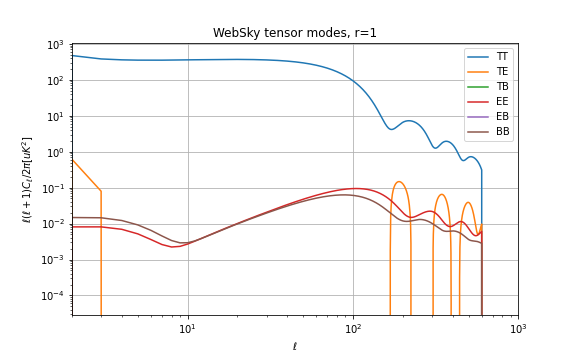WebSky
The Websky suite of simulated extragalactic component maps, determined from large scale structure light cone realizations and based on Lagrangian perturbation theory, Peak Patch Lagrangian halo finding, and modeling of SZ and CIB effects, can be read into PySM as precomputed external fits files using InterpolatingComponent. More information on the Peak Patch halo finding method can be found in Stein, Alvarez, and Bond (2018), and selected maps and halo catalogs are available from the Websky website. Some additional Websky-specific information and tools are available at the SO Websky model repository.
The cosmological parameters used for the websky simulations are available at on the websky website.
Both CIB and Radio galaxies have been provided as input maps at discrete frequencies to be interpolated over, the frequency span is 18.7 GHz to 1080 GHz.
As a temporary fix in order to support frequencies below 18.7 GHz, we have copied the 18.7 GHz map and renamed to 1 GHz.
Cosmic Infrared Background
The Planck (2013) CIB halo model is used, along with a halo occupation distribution. More details can be found here.
The current version of the maps are of intensity in units of \(MJy/Sr\) with filename convention cib_nu[FREQ].fits e.g. cib_nu0027.fits is the map of CIB intensity at 27 GHz and will be used by InterpolatingComponent at that frequency, and can be found on NERSC at /global/project/projectdirs/cmb/www/pysm-data/websky/0.4 or at https://portal.nersc.gov/project/cmb/pysm-data/websky/0.4/.
Kinetic SZ Effect
Provided is a map of the temperature fluctuation due to line of sight peculiar velocities of electrons along the line of sight. Electrons are assumed to follow a Navarro Frenk and White (NFW) profile interior to halos and second order Lagrangian Perturbation Theory (LPT) outside. The ksz map at \(N_{side}=4096\) can be found [in the Websky 0.4 folder at NERSC](https://portal.nersc.gov/project/cmb/pysm-data/websky/0.4/).
Lensing Convergence
A lensing convergence map is generated from the simulated matter distribution along the line of sight, assumed to follow an NFW profile interior to halos and second order LPT outside.
Primary and lensed CMB
The convergence map is used to lens a Gaussian realization of the unlensed primary CMB, which is then read into PySM as the primary lensed CMB through the WebSkyCMB class.
The primary CMB is obtained from parameters that match the Websky simulation, namely A_s = 2.022e-9, tau = 0.055, and all other parameters set to the websky values above, see the code, values not explicitely set are equal to the CAMB default, for example \(N_{eff}=3.046\). The CAR maps (where the lens remapping is done) have 1 arcminute resolution.
For convenience, see the parameters below:
\begin{aligned}
& \Omega_b = 0.049 \\
& \Omega_c = 0.261 \\
& \Omega_m = \Omega_b + \Omega_c \\
& \Omega_{\Lambda} = 1 - \Omega_b - \Omega_c \\
& h = 0.68 \\
& \sigma_8 = 0.81 \\
& n_s = 0.965 \\
& A_s = 2.022 e^{-9} \\
& N_{eff} = 3.046 \\
& \tau = 0.055
\end{aligned}
The theoretical power spectra for the unlensed and lensed CMB are available here https://github.com/ajvanengelen/webskylensing/tree/master/data. Each is a numpy array of shape (3, 3, N_l), giving the theory power spectrum C_l’s in the order ((TT, TE, TB), (ET, EE, EB), (BT, BE, BB)) in units of uK_CMB^2. They are obtained from the get_cmb_powerspecta.websky_cmb_spectra routine in that repository, which serves as a wrapper to CAMB.
CMB Tensor not yet implemented in PySM 3
The WebSkyCMBTensor provides the \(BB\) spectrum for the Websky cosmology from a model with \(r = 1\) (which of course needs to be scaled to whatever actual \(r\) value we want to use). This component is not lensed.
The tensor spectral index (\(n_t\)) in CAMB was set to 0.
The \(C_\ell\) from CAMB has power only up to \(\ell = 600\), however, given that the primordial BB signal is suppressed on scales smaller than the horizon scale at decoupling this should not matter in practice, for more details see this Github issue

